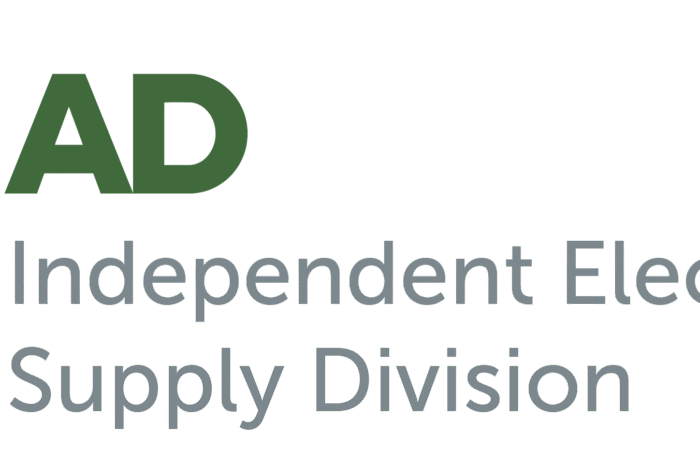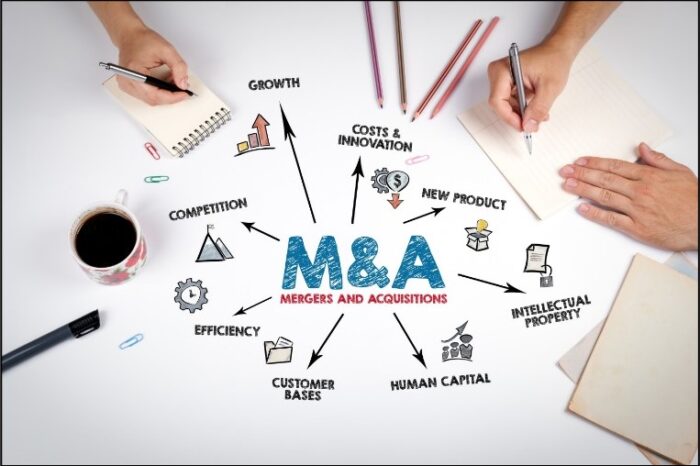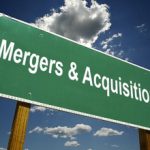Thoughts on the AD IMARK Merger
 Last week’s AD / IMARK Electrical merger news was the shocker of the year. Some commented that it may be of the past 5 years whereas others have foreshadowed this by asking “In the world of consolidation, when will the groups merge?”
Last week’s AD / IMARK Electrical merger news was the shocker of the year. Some commented that it may be of the past 5 years whereas others have foreshadowed this by asking “In the world of consolidation, when will the groups merge?”
We know know. We have IESD … Independent Electrical Supply Distributors. (At first read it took me back to one of the predecessors of IMARK … The Independent Electrical Distributor. IMARK was formed by the merger of TIED and WIED (yes, Western Independent Electrical Distributor) and I was involved in developing the IMARK Group name … a historical article will be shared next week.)
The inference was that IMARK “needed” to merge with AD due to having fewer “large” members and, at various times, more IMARK distributors were being acquired.
The two groups have/had different characteristics:
- IMARK Electrical, while being a member-owned cooperative, had over 600 members, albeit many are “small”, having joined when EDN/Equity became part of IMARK Electrical. So, the question became, “Would manufacturers support a group that has many small, perhaps medium-sized, members long-term?”
- AD, on the other hand, became a shareholder-owned organization in 2018 with the term “shareholder” meaning its distributor members. Due to its multi-vertical approach, AD was not going to go away. In 1981 AD, then known as Affiliated Distributors and founded by David Weisberg with 48 original members, some of which are still members, and now owners, of AD.
The IMARK Electrical versus IMARK Group distinction is important as IMARK Electrical is a different legal entity than IMARK Plumbing (which was formed when EDN / Equity and IMARK combined as EDN / Equity had a plumbing division) and Blue Hawk, the HVAC element, is its distinct entity. In essence, IMARK Group was a “federation” of purchasing cooperatives.
IMARK Plumbing was pretty emphatic in this LinkedIn post that they are not a party to the AD / IMARK Electrical deal and look forward to their continued independence. The posting said, “IMARK Plumbing, and its associated groups, will remain steadfast in their current independent operations.” John Aykroyd, President of IMARK Plumbing stated: “Our focus remains on delivering unparalleled value and support to our members. IMARK Electricals’ decision to join AD has no impact on IMARK Plumbing and rest assured, IMARK verticals will continue to operate independently …”
Further, the merger does not impact Canada. It appears that the challenge to a broader relationship, even for the electrical channel, is the legal structure. In Canada, IMARK Canada is a not-for-profit corporation whereas AD is a for-profit entity. Many feel that once the US electrical deal is completed, Canada will be addressed.
SIED (Southern Independent Electrical Distributors) group, which was the first electrical buying group in the industry, was founded in 1968. Some of those members remain IMARK Electrical members and I’m sure none of those founders ever thought that they would become part of AD.
As I shared with MDM, “This easily will be 2024’s story of the year in the electrical industry. IMARK’s roots go back almost 60 years ago when the first electrical cooperative buying group was formed in the south (SIED). I’m sure none of the founders of SIED, MAED, or WIED, which are the foundation of today’s IMARK, nor David Weisberg, who founded AD, envisioned the coming together of independent distributors. For distributors, it can bring opportunities in which some will enjoy better financial returns and more marketing resources. There inevitably will be some group operational synergies that should benefit members or be reinvested back into the business. Manufacturers may even get one less meeting to attend and may have some other benefits. With 725 independent electrical distributors, AD could evolve into the voice of the independent electrical channel. The combined entity represents some unique opportunities.”
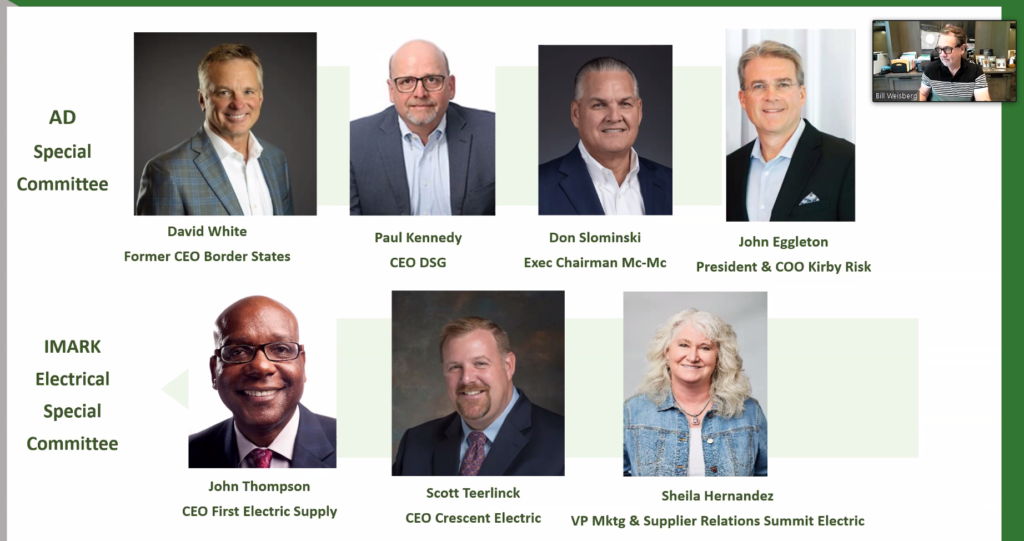
AD and IMARK Special Committees that Negotiated Merger to form IESD
The deal is liable to take a little time. AD’s electrical shareholder members have unanimously approved the deal. All are electronically connected and there are only a little more than 100 companies that needed to vote.
IMARK Electrical is a different dynamic. IMARK Electrical needs to contact each of its 600+ members. Some may still use @aol accounts (they are just small!). It’s unknown if by-laws require a majority of voting, a majority of members, 2/3rds, or all to approve an event such as this. Perhaps, purely from a legal viewpoint, it requires a dissolution of the organization and then members can become members of a new entity. Something for lawyers to address.
According to the press release, “both Boards have unanimously voted to approve the merger of IMARK Electrical and AD.” 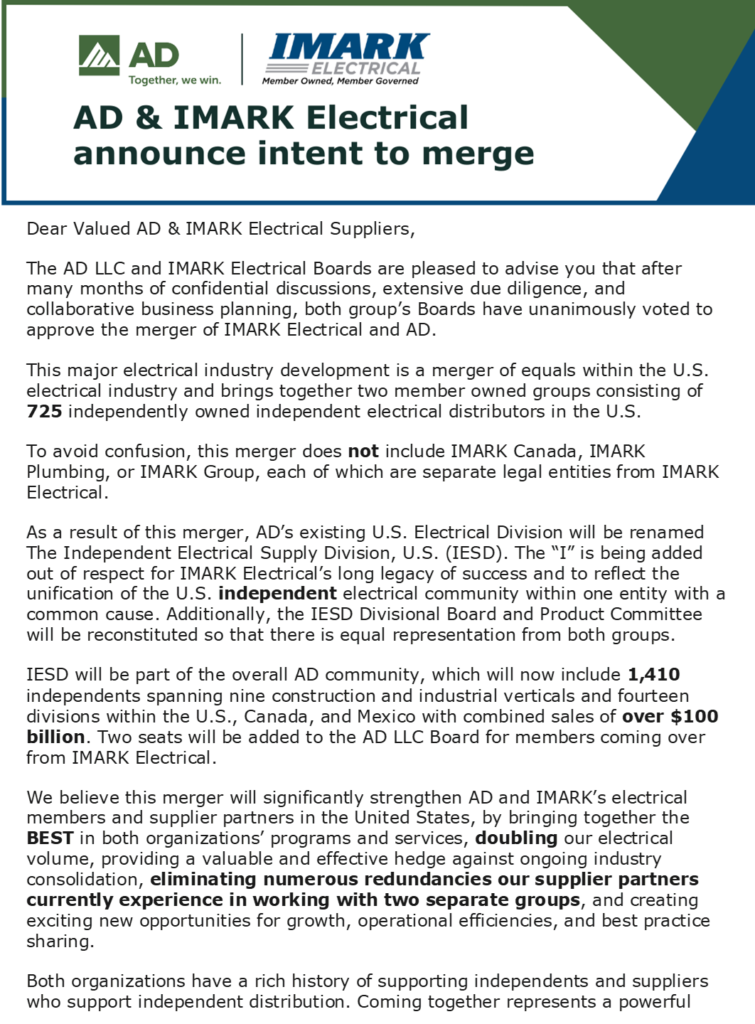
Feedback has ranged from:
- “Wow” (multiple times)
- Not surprised on either side. IMARK with no succession plan for any of the leadership and AD taking out the competition. Manufacturers will benefit greatly.
- It was inevitable that the best independents with their entrepreneurial direction, local market knowledge, and ability to make local decisions quickly continue to merge their advantages.
- I would never have guessed this to ever happen!!
Some have asked/commented:
- What does this mean to IMARK Electrical’s relationship with IMELCO?
- Will be interesting to see what happens with the manufacturers in each group who were not part of the other group.
- Good luck to the manufacturers who had a different deal for each group. The “highest” rebate percentage wins! (Which means manufacturers pay more, members benefit?)
- Will all IMARK Electrical members (inferring the smaller members) automatically become members of the new group? Will they have the same rebate or a reduced amount?
- Who will lead the new organization? (This was mentioned given that IMARK’s Steve Ruane recently announced his retirement. Jerry Knight is President Emeritus and previously retired and will be leaving the organization at the end of the year and Bob Smith, who is president for the second time, will presumably retire. Is the new leader Marisol Fernandez, Karen Baker (who wasn’t mentioned in the press release), someone else? What will be Bill Weisberg’s involvement?)
- What happens to IMARK Electrical members who are owned by CED and Graybar? (and for that matter, the members that have private equity as investors/partners?)
Presumably, there will be some infrastructure and operational cost savings. There are the aforementioned IMARK Electrical senior management retirements. Other areas will presumably be accounting personnel, IT personnel, and other administrative staff. Reduced meetings for members (and not all members attended any meeting) and another meeting off of the manufacturers’ calendars. The financial savings, however, as an incremental benefit to members will be minimal if even seen.
It is also interesting to observe that there are now 725 independently owned electrical distributors within one entity. This is more than the total number of independent distributors within NAED. It will be interesting to see if NAED and the new IESD identify opportunities to collaborate.
AD currently operates a number of well-attended, multi-industry, events that bring together Marketing and eCommerce, HR and Finance as well as has robust networking groups and an annual meeting that attracts most, if not all, of its electrical members and over 100 electrical manufacturers.
While NAED’s regional meetings attract non-marketing group manufacturers, marketing group manufacturers who participate in future IESD meetings will have a significant advantage in building relationships at multiple levels within a distributor and can potentially strengthen their incumbency within a distributor. Manufacturers outside the group will need to provide compelling offers, superior service (defined as ease of doing business) and incent their sales organization to pursue these distributors as well as strengthen their focus at end-users to strongly influence brand preference.
There’s lots to be done to get a deal finalized, but it presumably is more “mechanics” involving communicating with members, legal, and integration. The manufacturer discussions will occur in time (and some manufacturers were advised of the deal before the announcement, so the major issues have been addressed and major manufacturers assumably are supportive. Decisions about the CED / Graybar members will be addressed but, realistically the deal will be an end-of-year to coincide with fiscal calendars and the dynamics of rebate deals (and associated goals), so there is some time.
And then will be the combining/development of marketing programs, reconfiguring meetings (and there will inevitably be the need for larger meeting space). It will take time but, as the saying goes, “all good things take time.”
In a world driven by change, perhaps this was inevitable, and a convergence of events made this “the right time.”
And then there was one.
Thoughts? (feel free to post anonymously or send me your thoughts and I’ll post anonymously for you or give me a call.)





